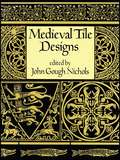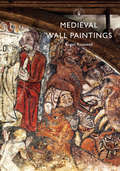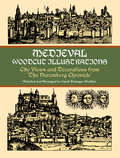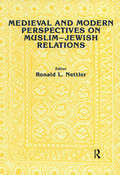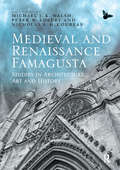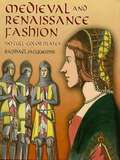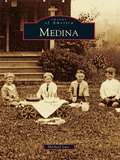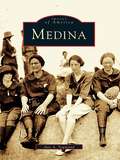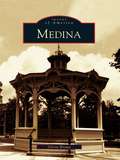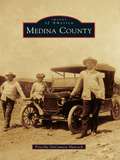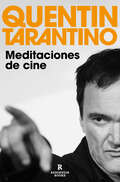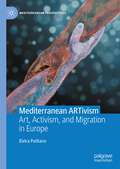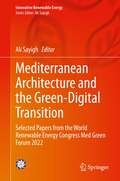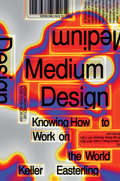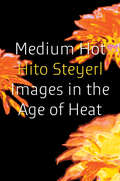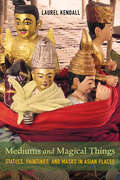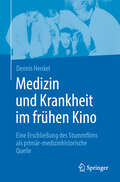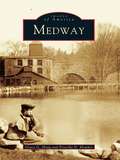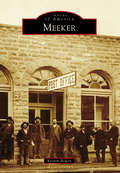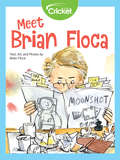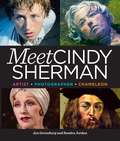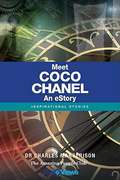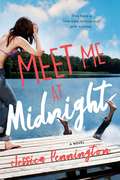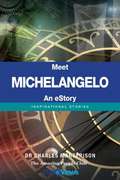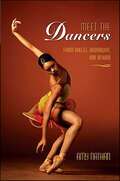- Table View
- List View
Medieval Tile Designs
by John Gough NicholsLittle remains of the decorative ceramic tiles that once paved the floors of medieval churches and cathedrals. Abraded by time and use, stolen by collectors, or covered by new flooring, these handsome ornamental paving stones (also known as "encaustic tiles") have become rarities. This practical, inexpensive, and comprehensive archive -- originally published in the mid-19th century -- has preserved many of those ancient designs for future generations. It represents an invaluable source of design inspiration for permission-free use by today's artists and craftspeople. Adapted largely from tile motifs that once adorned English churches in Winchester, St. Cross, Romsey, and Warblington, 146 handsome images display a host of characteristically medieval patterns -- crosses, churches, fleur-de-lis, stylized plant forms, mythological creatures, stars, abstract and geometric figures, and other authentic elements. These rich and evocative designs can be used to enhance a host of art and craft projects: wood burning, leathercraft, and stained glass work; fabric painting, ceramics, enameling, stenciling, or any other project calling for unique and powerful attention-getters.
Medieval Wall Paintings
by Roger RosewellWhat medieval wall paintings remain in English churches tend to be shadows of their former selves - rare fragments of art that have survived not only the Reformation, but successive waves of iconoclastic zeal and unsympathetic restoration. The whitewashed walls of most parish churches belie the riot of color and decoration that once adorned them, but the remnants of paintings tucked into corners or rescued from later layers of paint help us to understand the role of art in medieval religion. Roger Rosewell here offers a guide to the role played by medieval wall paintings, as religious, didactic and commemorative works of art, telling the stories of those who created them and those who used them on a daily basis. He also compares and contrasts religious and domestic wall paintings and uses beautiful color photography throughout to illustrate the story.
Medieval Woodcut Illustrations: City Views and Decorations from the Nuremberg Chronicle
by Carol Belanger GraftonPerhaps the most elaborately illustrated book of the 15th century, The Nuremberg Chronicle ranks with the Gutenberg Bible in terms of its magnificent craftsmanship and unsurpassed excellence of design. A rich selection of plates from this 1493 history of the world, long a treasured favorite of collectors, is now available in this inexpensive edition.This volume lovingly preserves the full grandeur of the original woodcuts, designed by the celebrated artists Michael Wolgemut and Wilheim Pleydenwurff. Some scholars believe that since Albrecht Dürer was Wolgemut's student at the time of the book's production, it is possible that he too contributed to the illustrations of the Chronicle. The plates shown here depict 91 locales as they appeared in 15th century Athens, Paris, Rome, Vienna, Jerusalem, Venice, Prague, Munich, Nuremberg, Florence, and many more. Included are 51 city views, 26 of them double-page spreads, each one exhibiting a new mastery of perspective -- as this book embodies a stage in the evolution of art from the naïve to its more conscious form. An additional 143 miscellaneous illustrations of figures and decorative objects round out this volume, all of whose cuts emanated from the celebrated printing presses of Anton Koberger.
Medieval and Modern Perspectives on Muslim-Jewish Relations (Studies In Muslim-jewish Relations Ser. #Vol. 2.)
by Ronald L. NettlerFirst Published in 1995. The life of Jews in medieval Baghdad or 18th-century Tunis may now be considered to be important as Jewish life in 13th-century Worms or 19th-century Poland. Islamic theological and exegetical writing on Judaism may now command as much interest as their counterparts in Christian literature, while the rich Islamic-Jewish cultural interchange over many centuries is clearly of great significance. Studies in Muslim-Jewish Relations will be a series of general volumes each including a wide range of subjects, periodic edited volumes each focusing on a certain theme, and a planned related monograph series which will publish authored volumes on more specialized aspects of the field. This volume is a collection of twelve essays.
Medieval and Renaissance Famagusta: Studies in Architecture, Art and History
by Peter W. Edbury Michael J. K. Walsh Nicholas S. H. CoureasThere was a time seven centuries ago when Famagusta's wealth and renown could be compared to that of Venice or Constantinople. The Cathedral of St Nicholas in the main square of Famagusta, serving as the coronation place for the Crusader Kings of Jerusalem after the fall of Acre in 1291, symbolised both the sophistication and permanence of the French society that built it. From the port radiated impressive commercial activity with the major Mediterranean trade centres, generating legendary wealth, cosmopolitanism, and hedonism, unsurpassed in the Levant. These halcyon days were not to last, however, and a 15th century observer noted that, following the Genoese occupation of the city, 'a malignant devil has become jealous of Famagusta'. When Venice inherited the city, it reconstructed the defences and had some success in revitalising the city's economy. But the end for Venetian Famagusta came in dramatic fashion in 1571, following a year long siege by the Ottomans. Three centuries of neglect followed which, combined with earthquakes, plague and flooding, left the city in ruins. The essays collected in this book represent a major contribution to the study of Medieval and Renaissance Famagusta and its surviving art and architecture and also propose a series of strategies for preserving the city's heritage in the future. They will be of particular interest to students and scholars of Gothic, Byzantine and Renaissance art and architecture, and to those of the Crusades and the Latin East, as well as the Military Orders. After an introductory chapter surveying the history of Famagusta and its position in the cultural mosaic that is the Eastern Mediterranean, the opening section provides a series of insights into the history and historiography of the city. There follow chapters on the churches and their decoration, as well as the military architecture, while the final section looks at the history of conservation efforts and assesses the work that now needs to be done.
Medieval and Renaissance Fashion: 90 Full-Color Plates (Dover Pictorial Archive Ser.)
by Raphaël JacqueminKnights clad in chain mail populate these pages, alongside crowned heads in royal regalia and common folk in their finest apparel. Scrupulously authentic in every detail, these images offer colorful portraits that span centuries of fashion, from the Middle Ages through the Renaissance.Raphaël Jacquemin was preeminent among the fashion illustrators and historians of nineteenth-century Europe's golden age of fashion design publications. His 1869 Iconographie Générale et Méthodique du Costume du IV au XIX Siècle drew upon manuscripts, reliefs, and effigies from the Louvre, university libraries, and other archives for the most striking and accurate fashion statements from the fourth through seventeenth centuries. This collection features ninety of Jacquemin's magnificent hand-colored engravings, a gallery of iconic portraits that have served as museum exhibits in their own right. Fashion designers, artists, costumers, and others seeking authenticity of period detail—as well as inspiration for contemporary styles—will find this book a splendid resource.
Medina
by Michael LuisMedina has long been recognized as the home to wealthy and influential members of Seattle's elite. Industry captains such as Clapp, Blethan, Gates, and Bezos have built estates along Medina's waterfront. Meanwhile, a diverse group of families with a variety of backgrounds have settled the uplands, creating a close-knit community. Farmers, including many of Japanese heritage, first settled the area in the late 1800s. Upon the arrival of the car ferry service to Seattle in 1913, Medina gradually evolved into a commuter suburb for the working class and wealthy alike. In 1940, the first Lake Washington floating bridge ushered in a new era, and with incorporation in 1955 and the opening of the Evergreen Point Bridge in 1963, Medina completed its transformation to a largely residential area. Despite its marvelous growth, Medina has successfully maintained its charm. A new generation of families arrived in the 1990s, filling classrooms and parks, and renewing Medina's original identity: close to the big city, but a world apart.
Medina (Images of America)
by Avis A. TownsendMedina traces the history of a community that came to life with the building of the Erie Canal. Located at a bend in the canal, halfway between Buffalo and Rochester, Medina became a regular stop for barge traffic. The famous Medina culvert--the only tunnel road that goes under the canal--is here, as are the falls and Medina sandstone, quarried and used not only in local buildings but also across the state and even at Buckingham Palace.
Medina (Images of America)
by Gloria BrownIn 1945, Pathfinder magazine selected the village of Medina as a "shining example of small town living" and, with the film company RKO Pathe, produced a 15-minute movie about Medina called Home Town USA. The film focused on the Victorian square and on the nearby tree-shaded streets lined with century homes. But the film did not tell the dramatic story behind the picturesque facade. Medina was hewn out of the Ohio wilderness by Connecticut Yankees, many of them Revolutionary War veterans who brought with them a tradition of democracy and strong community spirit. In 1848, a fire devastated the public square. The citizens rallied, and it was quickly rebuilt. In 1870, another fire wiped out most of the business district. Over the next decade, the square once again rose from the ashes, and the result was a village center filled with handsome Eastlake Victorian-style buildings. That public square sits at the heart of the community whose history this book puts on display.
Medina County
by Priscilla Dacamara HancockMedina County was founded in 1848 by settlers from Europe and the eastern United States. At the time, Native Americans still lived on that land, which they called "Comancheria." Full of hope for a better life, settlers tamed an unfamiliar landscape that was filled with prickly pear cactus, rattlesnakes, coyotes, mountain lions, bison, armadillos, pecans, persimmons, and mustang grapes. The first settlements in Medina County were Castroville, Quihi, Vandenburg, and D'Hanis. New Fountain, New D'Hanis, LaCoste, Rio Medina, Hondo, and others were established later. The settlers worked hard growing cotton and grain and raising cattle, and they retained their old-world customs and religious faith in the face of many challenges. With the building of the Medina Dam, farming changed for the better, and new immigrants arrived to help establish schools and communities. Today the proximity to San Antonio allows people to work in the city while maintaining their homes, farms, and ranches in Medina County.
Meditaciones de cine
by Quentin TarantinoLlega el esperado y ansiado primer libro de no ficción de Quentin Tarantino. Su libro más personal: un viaje íntimo por sus películas favoritas, relatado con una voz inconfundible. Probablemente, Quentin Tarantino sea uno de los mayores cineastas de la historia, pero de lo que no hay atisbo de duda es de que estamos hablando del espectador que mejor puede contagiar su pasión entusiasta por las películas que ha visto. Ahora, por fin llega el libro con el que tantos años soñaron él y sus seguidores. En Meditaciones de cine, Tarantino analiza desde los puntos de vista más insólitos y con su particular conocimiento enciclopédico varias películas clave del cine norteamericano de los setenta, todas ellas vistas en su más tierna infancia (de las más violentas a las más tórridas), así como revisitadas compulsivamente. El resultado es una obra tan rigurosa y reflexiva como juguetona y entretenida. Meditaciones de cine es, a la vez, crítica cinematográfica, teoría del cine, reportaje literario y unas memorias formidables, a la altura de clásicos del género como los de Hitchcock y Truffaut o Luis Buñuel. La crítica ha dicho...«Lo que une todos los hilos y temas de este libro es una rotunda verdad autobiográfica: que Tarantino ha sido espectador antes de ser cineasta y lo seguirá siendo durante muchísimo tiempo. Por eso es imbatible».The New York Times «Un libro en que se mezclan memorias, disquisiciones, arrebatos, entrevistas, datos recónditos, reflexiones fortuitas sobre actores de cine y directores, comentarios mordaces y demás obsequios sobre el viejo arte de sentarse en un patio de butacas a observar con placer imágenes en movimiento».Rolling Stone «No cuesta imaginar un universo alternativo (pero mucho más pobre) en el que Tarantino sea crítico de cine en vez de cineasta ganador de dos Óscar. Se nota que conoce bien lo que le gusta y sabe enganchar al lector con suma facilidad [...]. Un libro divertidísimo».San Francisco Chronicle «A nadie puede sorprender que la crítica cinematográfica de Tarantino sea tan rotunda, inteligente y asombrosa como sus películas».The New York Times «Descocado y audaz [...]. Nutre y apasiona a partes iguales, rebosa de vida en el mejor de los sentidos. Se nota que a Tarantino nada le gusta más que ir hasta el fondo de las películas».The Guardian «Lo que aquí ofrece Tarantino son cartas de amor muy bien documentadas a sus películas favoritas, salidas de uno de los momentos históricos más ambiciosos de Hollywood. Un ensayo de altos vuelos escrito por un artista único».Kirkus (Reseña destacada) «Tarantino trae la marcha y la exuberancia de su experiencia cinematográfica, su arte para contar historias y su humor agudo, así como una mezcla impresionante de historias personales, historia cinematográfica y crítica cinematográfica. [...] Este libro nos ofrece las historias chisporroteantes que hubo tras la producción y muchas críticas especulativas y exigentes. [...] Una celebración divertida e imprescindible del cine».Booklist (Reseña destacada) «Un libro totalmente cautivador, tan repleto de ideas ágiles y desopilantes, de opiniones contundentes y de disecciones afiladas de personajes y épocas que parece ideado para suscitar las más fecundas discusiones».The New Yorker «El entusiasmo, la generosidad y el singular punto de vista de Tarantino refuerzan sus argumentos, e incluso cuando derriba a sus héroes, lo hace por amor... inteligente y obsesivo, Tarantino es muy divertido y difícil de superar».Publisher's Weekly
Mediterranean ARTivism: Art, Activism, and Migration in Europe (Mediterranean Perspectives)
by Elvira PulitanoThis book is an interdisciplinary study aimed at re-imagining and re-routing contemporary migrations in the Mediterranean. Drawing from visual arts, citizenship studies, film, media and cultural studies, along with postcolonial, border, and decolonial discourses, and examining the issues from within a human rights framework, the book investigates how works of cultural production can offer a more complex and humane understanding of mobility in the Mediterranean beyond representations of illegality and/or crisis. Elvira Pulitano centers the discourse of cultural production around the island of Lampedusa but expands the island geography to include a digital multi-media project, a social enterprise in Palermo, Sicily, and overall reflections on race, identity, and belonging inspired by Toni Morrison’s guest-curated Louvre exhibit The Foreigner’s Home. Responding to recent calls for alternative methodologies in thinking the modern Mediterranean, Pulitano disseminates a fluid archive of contemporary migrations reverberating with ancestral sounds and voices from the African diaspora along a Mediterranean-TransAtlantic map. Adding to the recent proliferation of social science scholarship that has drawn attention to the role of artistic practice in migration studies, the book features human stories of endurance and survival aimed at enhancing knowledge and social justice beyond (and notwithstanding) militarized borders and failed EU policies.
Mediterranean Architecture and the Green-Digital Transition: Selected Papers from the World Renewable Energy Congress Med Green Forum 2022 (Innovative Renewable Energy)
by Ali SayighThis book contains selected papers presented during the World Renewable Energy Network’s biannual World Med Green Forum (MGF). The 2022 MGF highlights the role of renewable energy applications in the sustainable building sector with a focus on the Mediterranean region as a foundation for a truly positive energy future. MGF is an open roundtable for an international community of researchers, practitioners, and experts to discuss the most innovative and promising sustainable building technologies. The papers presented explore the intersection between twin transitions in policies, programs, projects, and experimentation, with the digital domain innovating the green building sector towards more reliable and inclusive planning and design practices in order to collectively envision future buildings and cities.
Medium Design: Knowing How to Work on the World
by Keller EasterlingHow to Design the World: Working Without SolutionsIn Medium Design everyone is a designer. But design, in this case, inverts the typical focus on object over its settings to concentrate on the medium—the matrix space between objects, events, and ideological declarations. It disrupts habitual modern approaches to the world&’s intractable dilemmas—from climate cataclysm to inequality to concentrations of authoritarian power. In a series of case studies dealing with everything from automation and migration to explosive urban growth and atmospheric changes, Medium Design offers spatial tools for innovation and global decision-making to challenge the authority of more familiar legal or economic approaches.From this perspective, solutions are mistakes and ideologies are unreliable guides. Rather than the modern desire for the new, designers find more sophistication in relationships between emergent and incumbent technologies. Encouraging entanglement, medium design does not try to eliminate problems but rather to put them together in productive combinations. And in the process of reconceptualizing design, Easterling puzzles over bulletproof powers, Stanley Kubrick, ISIS recruits, literary characters, and iconic activists in the hope of outwitting political deadlocks and offering forms of activism for modulating power and temperament in organizations of all kinds.
Medium Hot: Images in The Age of Heat
by Hito SteyerlWHAT IS THE FUTURE OF THE IMAGE IN THE AGE OF CLIMATE CHANGE AND ARTIFICIAL INTELLIGENCE?Hito Steyerl is one of the most celebrated artists of our time. Her work, both as an artist and a writer, has consistently challenged the political boundaries between art and technology. In this new collection of groundbreaking essays, she explores how AI, the use of large language models and the algorithmic creation of imagery transform our understanding of the world. She argues that such practices cannot be divorced from the economic and political conditions of the times.Medium Hot is a collection of scintillating meditations on the limits of art and technology: the essential handbook for the present conjuncture. The pieces here probe the manufacture and distribution of images in the age of AI and climate change. She asks whether art can be made not only by machines but for machines. She argues against the production of images that heat up the planet, disfranchise workers and fuel the arms trade, and questions whether such creations can even be called art.In an era of such rapid change, Steyerl does vital work investigating whether machine learning will infiltrate every aspect of our lives and what that means for the future.
Mediums and Magical Things: Statues, Paintings, and Masks in Asian Places
by Laurel KendallStatues, paintings, and masks—like the bodies of shamans and spirit mediums—give material form and presence to otherwise invisible entities, and sometimes these objects are understood to be enlivened, agentive on their own terms. This book explores how magical images are expected to work with the shamans and spirit mediums who tend and use them in contemporary South Korea, Vietnam, Myanmar, Bali, and elsewhere in Asia. It considers how such things are fabricated, marketed, cared for, disposed of, and sometimes transformed into art-market commodities and museum artifacts.
Medizin und Krankheit im frühen Kino: Eine Erschließung des Stummfilms als primär-medizinhistorische Quelle
by Dennis HenkelDas frühe Kino – der Stummfilm (ca. 1895-1927) – erscheint vielen Zuschauern auch heute noch in einem unschmeichelhaften Licht. Oft wird es als eine Art unfertiger Vorläufer des Ton-Kinos, des „richtigen Films“, wahrgenommen, welcher neben der Tonlosigkeit auch noch zu theatralischem Schauspiel, Schwarz-Weiß-Optik und hektisch-beschleunigter Wiedergabegeschwindigkeit neige – „Opas Kino“, sagt der Volksmund. Doch dieses Vorurteil verblasst: Der Stummfilm wird als Kunstform wahrgenommen. Der Autor begibt sich auf Spurensuche: Welchen historischen Beitrag kann die Erschließung dieser Kunstform mit ihrer Darstellung großer Fachgebiete wie Psychiatrie, Neurologie, Innere Medizin und Chirurgie leisten? Finden sich auch Disziplinen wie Zahnmedizin, Gynäkologie oder Dermatologie wieder? In 453 untersuchten „medizinischen Filmen“ finden sich viele ethische Kontroversen des frühen 20. Jahrhunderts – z. B. Geburtenkontrolle, Eugenik oder Homosexualität – wieder, was das Potential des Kinos als Zeitzeuge unterstreicht. Seine unterschätzten Funktionen als zeit- wie medizinhistorische Quelle und Spiegel der Gesellschaft werden herausgearbeitet, zudem können neue filmhistorische Strömungen definiert und das zentrale Leitmotiv der Medizindarstellung im frühen Film abgeleitet werden: die Iatro- und Pathophobie. Diese Ergebnisse offenbaren verblüffende Qualitäten einer rasch zum Massenmedium avancierten Kunstform, die Denken und Handeln der Kinogänger – und damit die Medizingeschichte – prägte. Der Autor Dr. Dennis Henkel studierte Philosophie, Theater-Film-Fernsehwissenschaften, Kunstgeschichte an der Universität zu Köln. Er promovierte zum Thema „Darstellung von Sucht und Drogen in frühen Film“ und ist seitdem als Dozent, Autor, und Herausgeber und am Institut für Geschichte und Ethik der Medizin in Köln tätig, zuletzt zum Thema Demenzdarstellung im Film. Eine abgewandelte Version des vorliegenden Buches wurde im Jahre 2024 als Habilitationsschrift an der Medizinischen Fakultät in Köln eingereicht.
Medway (Images of America)
by Priscilla N. Howker Grace G. HoagIncorporated in 1713, Medway began as a farming community of two hundred thirty-three. It was not long before the waterpower of the Charles River and Chicken Brook stimulated the formation of cotton and paper mills, straw and boot factories, and a variety of cottage industries. Through vintage images from the 1850s to the 1960s, Medway demonstrates the central importance of the Charles River and the thriving town that grew alongside it. Included are images of trains and streetcars; recreation, such as canoeing, picnicking, and fishing; Woodland Park, a popular stop that included a zoo; and the 1913 bicentennial celebration on the banks of the river. Today, the one-room schoolhouses are gone and the country stores have moved to the mall, but the open town meetings continue and Medway retains its small-town flavor.
Meeker
by Kristin BowenThe free-roaming Ute Indians were the first modern-day people to live in the White River valley. After mounting tensions erupted into violence and the Indian agency near present-day Meeker was attacked, the Ute were soon evicted from northwestern Colorado in 1881. By that time, adventurous people were pressing in at all sides to settle the area. Settlers drawn by land speculation and ranching populated this rural area. Ranching, hunting, guiding, and coal, oil shale, oil, and gas extraction were the ways people made their livings, or hoped to, in this region. Meeker had it all with a touch of Wild West and a promise of the American dream--and all in a setting that would lure Teddy Roosevelt himself. Inside this book are glimpses of the people, traditions, celebrations, and ways of life of those who lived here before us.
Meet Brian Floca
by Brian FlocaMeet artist and author Brian Floca and follow along as he takes you through how he creates the drawings for one of his books, Moonshot: The Flight of Apollo 11. You’ll see the drawings at every stage, from sketch to drawing to finished illustration!
Meet Cindy Sherman: Artist, Photographer, Chameleon
by Jan Greenberg Sandra JordanHow does someone become a ground-breaking artist? Does it start when you're very little and discover that you like to play dress up? Does it happen when you're ten years old and someone gives you a Polaroid camera for Christmas? Maybe it begins in college, when you're finally on your own to discover the world as you see it for the first time.Looking at the life of legendary photographer Cindy Sherman, Jan Greenberg and Sandra Jordan have created an unconventional biography, that much like Cindy Sherman's famous photographs, has something a little more meaningful under the surface. Infusing the narrative with Sherman's photographs, as well as children's first impressions of the photographs, this is a biography that goes beyond birth, middle age, and later life. It's a look at how we look at art.
Meet Coco Chanel - An eStory
by Charles MargerisonMeet Coco Chanel! She was one of the most influential style icons of all time. Everyone knows the Chanel brand, but far fewer know the amazing rags-to-riches story behind it. Take a journey from a poor house in Saumur to a convent to the glitz and glamour of Paris, where Chanel opened her first shop. Be inspired by her amazing story, as it comes alive through BioViews®.A BioView® is a short biographical story, similar to an interview. These unique stories provide an easy way of learning about amazing people who made major contributions to our world.
Meet Me at Midnight
by Jessica PenningtonTeens waging a war of practical jokes declare peace when they fall for one another in this charming YA romantic comedy from Jessica Pennington.They have a love-hate relationship with summer.Sidney and Asher should have clicked. Two star swimmers forced to spend their summers on a lake together sounds like the perfect match. But it’s the same every year—in between cookouts and boat rides and family-imposed bonfires, Sidney and Asher spend the dog days of summer finding the ultimate ways to prank each other. And now, after their senior year, they’re determined to make it the most epic yet. But their plans are thrown in sudden jeopardy when their feud causes their families to be kicked out of their beloved lake houses. Once in their new accommodations, Sidney expects the prank war to continue as usual. But then she gets a note—Meet me at midnight. And Asher has a proposition for her: join forces for one last summer of epic pranks, against a shared enemy—the woman who kicked them out. Their truce should make things simpler, but six years of tormenting one another isn’t so easy to ignore. Kind of like the undeniable attraction growing between them.At the Publisher's request, this title is being sold without Digital Rights Management Software (DRM) applied.
Meet Michelangelo - An eStory
by Charles MargerisonMeet Michelangelo, who was born in 1485 in small village in Tuscany. In this inspirational story from The Amazing People Club, travel with him to Rome at the age of 21 and better understand how he came to complete some of the world's most influential pieces of art, including David and the awe-inspiring ceiling of the Sistine Chapel, which took him 4 years to complete. You'll hear about the challenges he faced in his long life and gain a unique perspective on the life and achievements of one of the world's most influential artists. Michelangelo's story comes to life through BioViews®. These are short biographical narratives, similar to interviews. They provide an easy way of learning about amazing people who made major contributions and changed our world.
Meet the Dancers: From Ballet, Broadway, and Beyond
by Amy NathanLots of kids enjoy dancing, but what motivates them to push past the sore muscles, early-morning technique classes, and crazy schedule required to become a professional dancer? In this book, dancers from many backgrounds talk about their different paths to success in ballet, modern, jazz, Broadway, and hiphop. They also share advice and helpful tips, such as: • practice interpreting the music and the mood of a movement, even when you're doing a standard warm-up exercise • try to be in the front row at auditions so you can see what's going on and so the judges know you're eager to be seen
